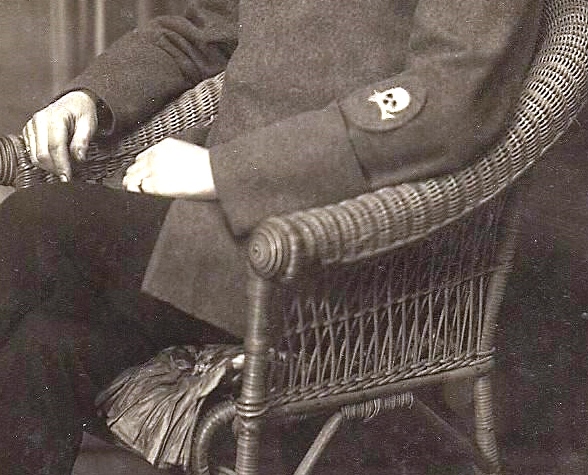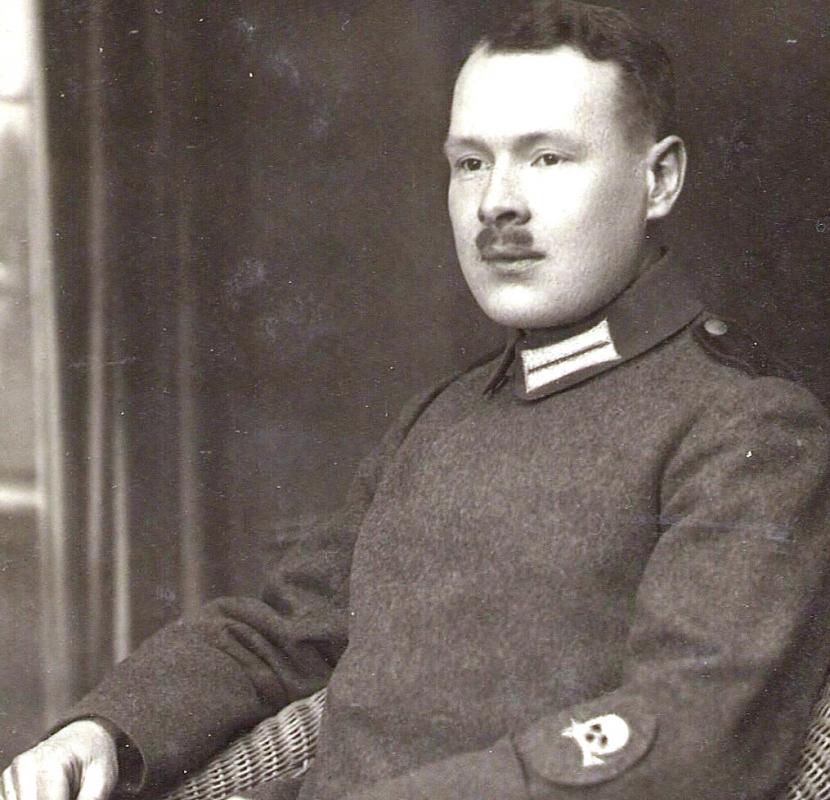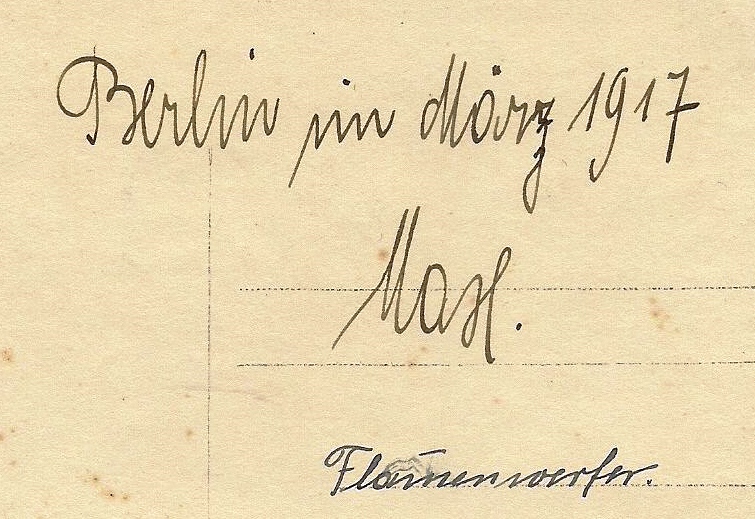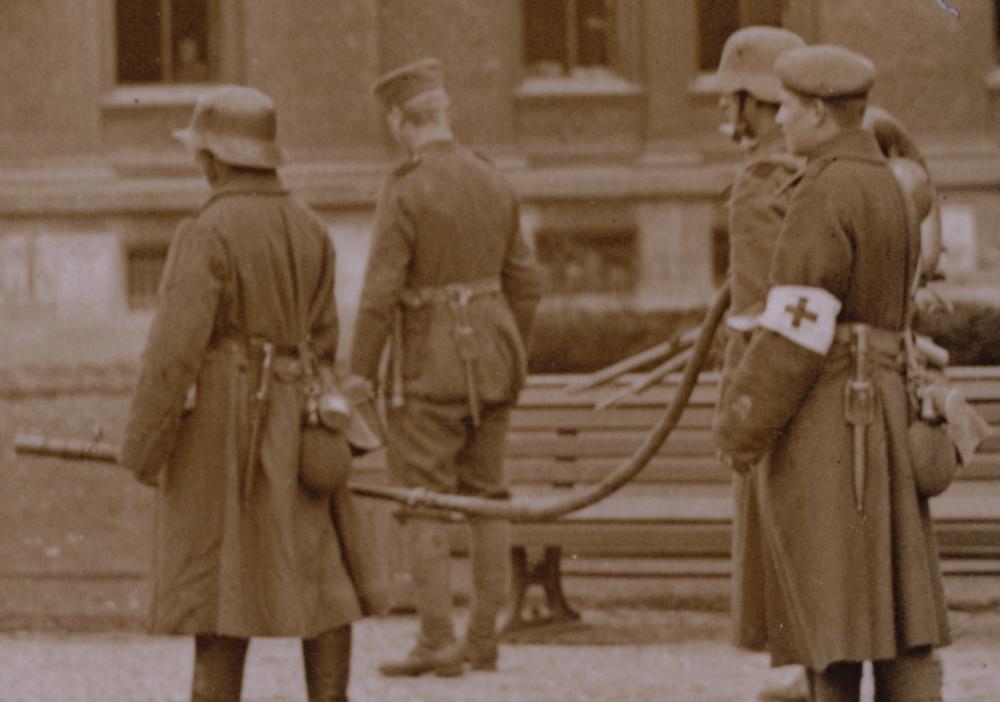
Gilles
-
Posts
84 -
Joined
-
Last visited
Content Type
Profiles
Forums
Blogs
Gallery
Events
Store
Posts posted by Gilles
-
-
On 30/11/2022 at 20:04, Klaus P. Schad said:
Hi Klaus,
The Pionier looking through the binocular is in my opinion a member of the G.R.P.R.
He’s wearing the Garde Pionier uniform with Litzen and black shoulder boards
I'd rather say Garde-Schütze because of the three buttons and the "waves"
0 -
Isn't he wearing the same pattern (or a very similar?) as a tiepin? Look at his collar.
If he happened to wear twice Olbernhau's coat of arms, this could maybe identify him as a civil servant?
Have you got a date on the back of the picture, any emboss or stamping of the photograph?
0 -
Wouldn't silver have a mark?
0 -
We wish you good luck in this very interesting but, as already said, very tricky collecting topic
0 -
"Small is beautiful"...
0 -
Brian, I agree with the black backing for the FK and provisional RW but I would have thought that the badge was just private purchased.
A very nice picture of a member of the III. Abteilung!
0 -
I have a ring of the officers pattern but as it doesn't have LIR in it, I wasn't quite sure. Does yours have the marking?
Regards
0 -
Yes, it's the Austrian tinnie of the 21st. Korps 1916
0 -
Could be Freikorps, compare with the badge of the "Freie Nachrichten-Truppen" shown in Ingo Haarcke's reference book #621.1 page 106
0 -
An astonishing flag that would be a reason to move to an "Altbau Wohnung" with high ceilings!
I agree with Don, as a matter of luck, many a summit is being fortunately hidden... by a lower summit!
0 -
Another photo showing a badge placed ................... but not sewn !!
Dated this time ............... 1917.
TK looks very white !!

Of all the pictures with the patch shown in this long thread, only the posts #1780 and #1785 do show the sleeve badge being just pinned or maybe lain on the sleeve (for the time of the picture?). Both have in common that they were shot in a studio, not in the field. Maybe they just show two pioneers that have been given the badge and were eager to show off and went to the photographs's, before having it properly sewn on.
Regards
G.
0 -
Two bizarre anomalies in one photo. Note the medic on the right.
1. He's got his Totenkopf on his OVERCOAT sleeve. Each man was issued only one badge. Maybe he was so proud of the death's head that he didn't mind tearing it off and resewing it on, depending on the season. I've never seen one on an overcoat before.
2. He's a medic. Normally medics were attached from the Medical Companies. A medic wouldn't have been trained on flamethrowers. It's possible that he's wearing the red cross brassard because he's simply been DEEMED a medic by the unit, but I've never seen medical personnel with a flamethrower badge.Thomas,
a seldom view indeed! The picture is from the Revolution time, when soldiers started to take liberties with uniform regulations.
If they were only given one example, maybe they were given the possibility to buy another one?
Regards
0 -
It was already in another auction and it is the second time for sale. It is the same skull.
Ok, I first thought it was yours
0 -
What is this? Looks old, dark silver patina back....means nothing....
Details like teeth look not very sharp.
Ideas?
It could be the sleeve insignia of the Freikorps Elisabeth.
A German dealer offers it:
What surprises me is that both your insignias show the very same conditions and stains (check several places)Did he just use your pictures?
Regards
Gilles
0 -
Chris
I'd say IR 90 (Mecklenburg)
Does the belt buckle confirm this?
Regards
Gilles
0 -
I'd be very surprised, when you consider the density of the collectors & dealers in this very city that no information on a specific Hamburg distinction ever trickled to one of them (Weitze, Patzwall, Niemann, Hüsken, Blass & many others) and then to the net. To my opinion, this document of this arm award that has the form of a breast award is not trustworthy.
G.
0 -
What surprises me is that I may, just like Jock, still have plenty to see, but the supposedly most efficient search engine of the internet doesn't have a clue either.
Hakenkreuz-Ärmelabzeichen (with or without 27.1.1934) doesn't give any (reasonable) result.
It makes me somewhat suspicious but, of course, I'd be very pleased to change my mind.
Regards
G.
0 -
Thomas,
you write:
Badge in the middle of the sleeve cuff, flamethrower operators. Badge below the left elbow, flamethrower operators of Sturmbataillon Nr. 5 (Rohr). Badge at the top of the sleeve cuff, machine gunner. And badge overlapping the cuff and sewn halfway on the sleeve, grenade-launcher crew.
If I take from your interesting theory of the four skull positions the one exemple of the Sturmbataillon Rohr, how do you then explain the period picture shown on #482750?
Regards
Gilles
#4827500 -
(Post 135) The badge was unofficial, so there are many different styles. They vary in size, too.
This statement is unfortunately not supported by any photographic evidence.
On the contrary, several sources ( Jaeger7's post #133 , Larcade's book with Maurice Sublet's period picture (p.35) as well as the sleeve patch on black velvet (p.36), the patch shown more recently in the book by Laparra & Hesse about the StBtl Rohr ( p. 96 & 113) seem to establish one precise, definite pattern.
Regards
0 -
(Post #121)
... You can see the light-colored blob of the crown badge worn above the cuff by Rohr's man (left), and you can see the Totenkopf sleeve badge, Garde-Litzen, and black shoulder straps worn by the flamethrower pioneer (right) ...
... Sorry my photo isn't better...
I'm afraid,indeed, that the picture does not enable to draw any conclusions. Aren't there just stains or shadows?
Moreover, it would be a big surprise to see Wilhelm II inspecting troops wearing uniform paticularities that would not have allowed. The emperor was very engaged in this matter (see the project below from his very hand) and the military hierarchy always rejected "local" initiatives, for sure especially before being inspected by the emperor himself.

Uniformentwurf der Schutztruppenuniform mit eigenhändigen Bemerkungen Kaiser Wilhelms II. Figur Nr. 1 mit dem Säbel von 1849 und Figur Nr. 2 mit dem Klappmesser.
[Joseph Kürschner: Kaiser Wilhelm II. als Soldat und Seemann, Berlin, 1902]
found on the homepage of the Gesellschaft für Heereskunde
Regards
0 -
No luck. Is there an online database that shows list list of patents by company and date?
I'm afraid not:
0 -
Is it sleeve size?
Did the Reichswehr have AOK ?
Chris, at least no AOK 18, as Andreas checked it:
http://gmic.co.uk/index.php/topic/61055-reichswehr-insignia/
G.
0 -
Hi Chip,
The ottoman theory doesn't sound credible anymore?
G.
0 -
Stefan,
How heavy is the skull, due to the metal thread? Can reducing the patch to more or less its metall part have given it a greater stability? Would otherwise have a heavy skull been "floating" on a larger cloth patch? On other badges (imperial shooting prizes, Freikorps patches...) you usually find or may find a counter-plate that gives the badge stability.
Otherwise, they may have just found it more elegant... Some enlisted men seem to have done it as well.
Gilles
0





Flammenwerfer! Flames, skulls and stuff
in Germany: Imperial Uniforms, Headwear, Insignia & Personal Equipment
Posted
Hi Klaus,
To your picture posted on November 30, 2022: According to me, the black shoulder board is only the shadow of a feldgrau shoulder board because due to the position of the arms holding the field-glasses.
Best regards
Gilles